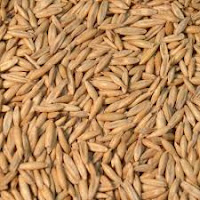Grains - who and what are they?!
This is just a
little bit about the various grains that people feed horses. You may feed them
individually or find them in your commercial mix (eg. Cool ‘n cooked). I myself
feed oats to one horse and maize to another, as well as beet pulp. I thought I
knew more than I did, so I researched them a little more and said I’d share what I learned-
cos I’m nice like that J
An individual
grain is actually the seedhead of the plant, containing the nutrient store for
the germ (embryo) from which a new plant develops. It consists of a coat, a
starchy endosperm, and the germ itself. Some grains—such as barley, rice, oats,
and husked sorghum (milo)—have a fused husk or hull, which provides extra
fiber; others—such as corn, wheat, rye, and millet—do not. [1]
 |
| Oats |
Oats are the most commonly known grain
when it comes to horses. Oats were the staple food for equines because they
were readily available, cheap, and most importantly, best suited to their
digestive systems. They have the highest fibre content and lowest energy of all
the grains, making them the safest to feed. The grain size also meant that
horses could chew them effectively, maximizing their goodness. However, as the
horse’s role began to shift from work to leisure, its energy requirements
changed. Days off and less intensive work schedules led to problems with horses
tying up.[2]
Oats are reported to make up more than 30%
of all commercially prepared horse feeds. Horses seem to prefer oats over many
other grains. Their popularity with owners and trainers may have more to do
with habit and a lack of familiarity with other cereal grains than anything
else.
 |
| Barley |
Barley is very
similar to oats as a feed. Barley is lower in fibre than oats and is classified
as a ‘heavy’ feed. It’s more energy dense and weighs more per unit of volume
than oats. Although barley grains resemble smallish oats, they are harder. It is usually rolled before feeding. If the
barley kernel is crushed or ground, it is too heavy and can cause colic unless
mixed with a bulkier feed. It can be
described as in ‘in-between’ grain in many ways. Barley provides more
digestible energy and total available nutrients than oats, but it doesn’t reach
the levels of corn/maize. It is slightly higher in protein than either oats or
corn, making it a good choice for breeding stock and young horses. It’s
considered a good feed for putting condition on a horse.
Corn/maize is one
of the most energy-dense feeds and contains a high content of carbohydrate.
Maize has high energy content per unit of weight and a high weight per unit
volume. Its high energy content has led to it becoming known as ‘too hot’ a
feed for horses. It’s high in starches. Starch is the most common carbohydrate
in the human diet and is contained in many staple foods; cereals and root
vegetables (eg. potatoes). But the
greatest amount of internal heat in the horse’s body is generated through the
microbial fermentation of fibre, not starches, increasing the amount of hay in
your horse’s diet in winter will generate more body heat than will increasing
the amount of maize he eats. [3]
Molasses is a
popular component of mixed concentrate rations. It’s a by-product of the sugar
refining industry. It is a cheap source of energy, and it reduces dust in the
feed.
Beet pulp can be
dehydrated and used as a source of a fiber and energy. It is relatively high in
energy and calcium but low in protein, phosphorus and B vitamins. It is
included in many high-performance diets to help ensure adequate fiber intake
while meeting energy needs. The two forms of beet pulp on the market are shredded (available with or without molasses) and pelleted ( usually contains some molasses to bind it). Molasses content might affect your choice if you have a horse that needs a low sugar or low potassium diet.
People usually soak beet pulp. The shredded beet pulp soaks up the water faster than the pellets. It is recommended to soak it until it soaks up the liquid, anything from 15 mins to a few hours. A ratio of 2 parts water to 1 part beet pulp is usually applied.



Comments
Post a Comment